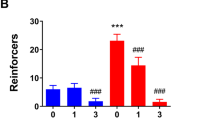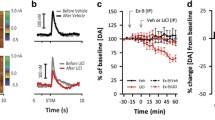Abstract
Rats were trained to press a bar for sucrose reward on a random-interval (RI) schedule and footshock punishment was then introduced for 3-min intrusion periods (signalled by a tone) on an independent RI schedule. Shock intensity was individually adjusted to produce stable intermediate levels of response suppression during the tone for each animal. Groups of animals were then allocated to a number of separate experiments in which they were systemically injected with anxiolytics (chlordiazepoxide HCl or sodium amylobarbitone), GABA antagonists (picrotoxin or bicuculline), the GABAA agonist muscimol, the GABAB agonist baclofen, an antagonist (RO 15-1788) at the benzodiazepine receptor and, an inverse agonist (FG 7142) at this receptor. The results showed that the alleviation of punishment-induced suppression of barpressing produced by chlordiazepoxide was blocked or partially blocked by RO 15-1788, picrotoxin and bicuculline but not by FG 7142; that picrotoxin (but not FG 7142) increased the suppression of responding by punishment; that neither muscimol nor baclofen affected responding on their own, but their combination weakly but reliably released punished responding from suppression; and that the anti-punishment effect of amylobarbitone was unaffected by either picrotoxin or bicuculline, though the barbiturate reversed the punishment-enhancing effect of picrotoxin. These results are discussed in the light of the hypothesis that anxiolytic behavioural effects are due to increased GABAergic inhibition.
Similar content being viewed by others
References
Baraldi M, Grandison L, Guidotti A (1979) Distribution and metabolism of muscimol in the brain and other tissue of the rat. Neuropharmacology 18:57–62
Billingsley ML, Kubena RK (1978) The effects of naloxone and picrotoxin on the sedative and anticonflict effects of benzodiazepines. Life Sci 22:897–906
Bonetti EP, Pieri L, Cumin R, Schaffner R, Pieri M, Gamzu ER, Muller RKM, Haefely W (1982) Benzodiazepine antagnist RO 15-1788: neurological and behavioral effects. Psychopharmacology 78:8–18
Bowery NG, Hill DR, Hudson AL (1983) Characteristics of GABAB receptor binding sites on rat whole brain synaptic membranes. Br J Pharmacol 78:191–206
Braestrup C, Nielsen M, Olsen CE (1980) Urinary and brain β-carboline-3-carboxylates as potent inhibitors of brain benzodiazepine receptors. Proc Natl Acad Sci USA 77:2288–2292
Cananzi AR, Costa E, Guidotti A (1980) Potentiation by intraventricular muscimol of the anticonflict effect of benzodiazepines. Brain Res 196:447–453
Corda MG, Blaker WD, Mendelsen WB, Guidotti A, Costa E (1983) β-carbolines enhance shock-induced suppression of drinking in rats. Proc Natl Acad Sci 80:2072–2076
Costa E (Ed) (1983) The benzodiazepines: from molecular biology to clinical practice. Raven Press, New York
Cowen PJ, Green AR, Nutt DJ, Martin IL (1981) Ethyl-β-carboline carboxylate lowers seizure threshold and antagonizes flurazepam-induced sedation in rats. Nature (Lond) 290:54–55
Dorow R (1982) β-carboline monomethylamide causes anxiety in Man. Abst. 13th Congress Collegium Internationale Neuropsychopharmacologicum, p 175
Feldon J, Lerner T, Levin D, Myslobodsky M (1983) A behavioral examination of convulsant benzodiazepine and GABA antagonist, RO 5-3663, and benzodiazepine receptor antagonist RO 15-1788. Pharmacol. Biochem Behav 19:39–41
File SE, Lister RG, Nutt DJ (1982) The anxiogenic action of benzodiazepine antagonists. Neuropharmacology 21:1033–1037
Fung S-C, Fillenz M (1983) The role of pre-synaptic GABA and benzodiazepine receptors in the control of noradrenaline release in rat hippocampus. Neurosci Lett 42:61
Geller I, Seifter J (1960) The effects of meprobamate, barbiturates, D-amphetamine and promazine on experimentally induced conflict in the rat. Psychopharmacologia 1:482–492
Gherezghiher T, Lal H (1982) RO 15-1788 selectively reverses antagonism of PTZ-induced discriminative stimuli by benzodiazepines but not by barbiturates. Life Sci 31:2955–2960
Gray JA (1977) Drug effects on fear and frustration: possible limbic site of action of minor tranquillizers. In: Iversen LL, Iversen SD, Snyder SH (Eds) Handbook of psychopharmacology, vol 8. Plenum, New York, pp 433–529
Gray JA (1982) The neuropsychology of anxiety: An enquiry into the function of the septo-hippocampal system, Oxford University Press, Oxford
Gray JA, Ball GG (1970) Frequency-specific relation between hippocampal theta rhythm, behavior and amobarbital action. Science 168:1246–1248
Gray JA, McNaughton N (1983) Comparison between the hehavioural effects of septal and hippocampal lesions. A review. Neurosci Biobehav Rev 7:119–188
Gray JA, McNaughton N, James DTD, Kelly PH (1975) Effect of minor tranquillisers on hippocampal theta rhythm mimicked by depletion of forebrain noradrenaline. Nature 250:424–425
Hodges HM, Green S (1984) Evidence for the involvement of brain GABA and serotonin systems in the anti-conflict effects of chlordiazepoxide in rats. Behav Neural Biol 40:127–154
James DTD, McNaughton N, Rawlins JNP, Feldon J, Gray JA (1977) Septal driving of hippocampal theta rhythm as a function of frequency in the free-moving male rat. Neuroscience 2:1007–1017
Locock RA, Baker GB, Micetich RG, Coutts RT, Benderly A (1982) Interaction of beta-carbolines with the benzodiazepine receptor. Structure-activity relationships of amide derivatives of beta-carboline and tetrahydro-beta-carboline. Prof Neuropsychopharmacol Biol Psychiatr 6:407–410
Maggi A, Enna SJ (1979) Characteristics of muscimol accumulation in mouse brain after systemic administration. Neuropharmacology 18:361–366
McNaughton N, James DTD, Stewart J, Gray JA, Valero I, Drewnowski A (1977) Septal driving of hippocampal theta rhythm as a function of frequency in the male rat: effects of drugs. Neuroscience 2:1019–1027
Mellanby J, Gray JA, Quintero S, Holt L, McNaughton N (1981) Septal driving of the hippocampal theta rhytm: a role for gamma-aminobutyrate in the effects of minor tranqullizers? Neuroscience 6:1413–1421
Millenson JR (1971) A general language for on-line control of psychological experimentation. Behav Sci 16:248–256
Ninan PT, Insel TM, Cohen RM, Cook JM, Skolnick P, Paul SM (1982) Benzodiazepine receptor-mediated experimental anxiety in primates. Science, 218:1332–1334
O'Keefe J, Nadel L (1978) The hippocampus as a cognitive map. Clarendon Press, Oxford
Olsen RW (1981) GABA-benzodiazepine-barbiturate receptor interactions. J Neurochem 37:1–2
Olsen RW, Leeb-Lundberg F (1981) Convulsant and anticonvulsant drug binding sites related to the GABA receptor/ionophore system. In: Morselli PL, Lloyd KG, Loscher W, Meldrum B, Reynolds EH (eds) Neurotransmitters, seizures and epilepsy. Raven Press, New York, pp 151–164
Petersen EN, Paschelke G, Kehr W, Nielsen M, Braestrup C (1982) Does the reversal of the anticonflict effect of phenobarbital by beta-CCE and FG 7142 indicate benzodiazepine receptor-mediated anxiogenic properties? Eur J Pharmacol 82:217–221
Petersen EN, Scheel-Kruger J (1982) The GABA-ergic anticonflict effect of intra-amygdaloid benzodiazepines demonstrated by a new water lick conflict paradigm. In: Spiegelstein MV, Levy A (eds) Behavioral models and the analysis of drug action. Elsevier, Amsterdam, pp 467–473
Quintero EM (1983) Gamma-aminobutyric acid and its relation to the anti-anxiety action of minor tranquillisers. Unpublished D. Phil Dissertation, Oxford University
Rawlins JNP, Feldon J, Gray JA (1980a) Discrimination of response-contingent and response-independent shock by rats. effects of chlordiazepoxide HCl and sodium amylobarbitone. Q J Exp Psychol 32:215–232
Rawlins JNP, Feldon J, Salmon P, Gray JA, Garrud P (1980b) The effects of chlordiazepoxide HCl administration upon punishment and conditioned suppression in the rat. Psychopharmacology 70:317–322
Soubrié P, Thiébot MH, Simon P (1979) Enhanced suppressive effects of aversive events induced in rats by picrotoxin: possibility of GABA control on behavioural inhibition. Pharmacol Biochem Behav 10:463–469
Stein L, Wise CD, Belluzzi JD (1975) Effects of benzodiazepines on central serotonergic mechanisms. In: Costa E, Greengard P (eds) Mechanisms of action of benzodiazepines (Adv Biochem Psychopharmacol vol 14), Raven Press, New York, pp 29–44
Thiébot H, Jobert A, Soubrié P (1979) Effets comparés du muscimol et du diazépam sur les inhibitions du comportement induites chez le rat par la nouveauté, la punition et le non-renforcement. Psychopharmacology 61:85–89
Zakusov VV, Ostrovskaya RU, Kozhechkin SN, Markovich VV, Molodavkin GM, Voronina JA (1977) Further evidence for GABA-ergic mechanisms in the action of benzodiazepines. Arch Int Pharmacodyn Ther 229:313–326
Author information
Authors and Affiliations
Rights and permissions
About this article
Cite this article
Quintero, S., Henney, S., Lawson, P. et al. The effects of compounds related to γ-aminobutyrate and benzodiazepine receptors on behavioural responses to anxiogenic stimuli in the rat: Punished barpressing. Psychopharmacology 85, 244–251 (1985). https://doi.org/10.1007/BF00428424
Received:
Accepted:
Issue Date:
DOI: https://doi.org/10.1007/BF00428424




